01 Lattice Design Book
- 格式:pdf
- 大小:914.29 KB
- 文档页数:39
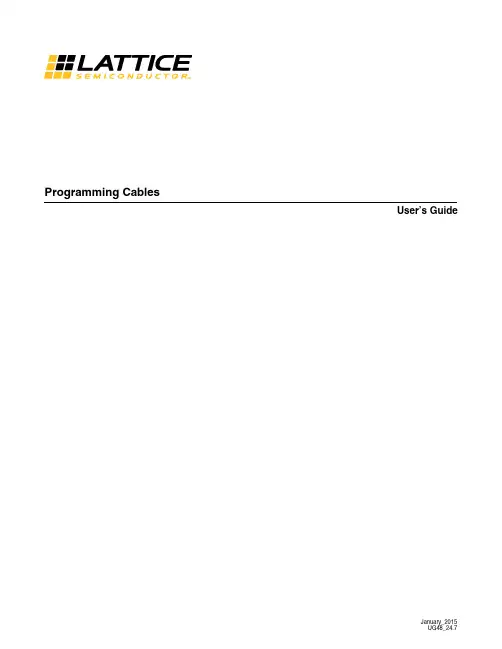
Programming CablesUser’s GuideFeatures•Support for all Lattice programmable products–1.2 V to 3.3 V programming (HW-USBN-2B)–1.2 V to 5 V programming (All other cables)–Ideal for design prototyping and debugging•Connect to multiple PC interfaces–USB (v.1.0, v.2.0)–PC Parallel Port•Easy-to-use programming connectors•Versatile flywire, 2 x 5 (.100”) or 1 x 8 (.100”) connectors•6 feet (2 meters) or more of programming cable length (PC to DUT)•Lead-free/RoHS compliant constructionFigure 1. USB Cable – HW-USBN-2BProgramming CablesLattice Programming Cable products are the hardware connection for in-system programming of all Lattice devices. After completion of the logic design and creation of a programming file with the Lattice Diamond®, ispLEVER® Clas-sic or PAC-Designer® software, the Lattice Diamond Programmer, or Lattice's ispVM™ System software is used to control the programming of devices directly on the PC board. No additional components are required to program a device.After you complete your logic design and create a programming file with the Lattice Diamond/ispLEVER Classic development tools, you can use Diamond Programmer or ispVM™ System software ispVM™ System software or Diamond Programmer to program devices on your board. The ispVM System/Diamond Programmer software auto-matically generates the appropriate programming commands, programming addresses and programming data based on information stored in the programming file and parameters you set in Diamond Programmer/ispVM Sys-tem. Programming signals are then generated from the USB or parallel port of a PC and directed through the Pro-gramming Cable to the device. No additional components are required for programming.Diamond Programmer/ispVM System software is included with all Lattice design tool products and is available for download from the Lattice web site at .Programming Cable Pin DefinitionsThe functions provided by the Programming cables correspond with available functions on Lattice programmable devices. Since some devices contain different programming features, the specific functions provided by the Pro-gramming cable may depend on the selected target device. ispVM System/Diamond Programmer software will automatically generate the appropriate functions based on the selected device. See Table 1 for an overview of the Programming cable functions.Table 1. Programming Cable Pin DefinitionsProgramming Cable Pin NameProgramming CablePin TypeDescriptionVCCProgramming VoltageInputConnect to V CC or V CCJ plane of the target device. T ypical I CC = 10mA. Y our board design supplies the power for V CC . Note: This may not be the same as a target device’s V CCO plane.SDO/TDO Test Data Output Input Used to shift data out via the IEEE1149.1 (JT AG) programming standard.SDI/TDITest Data InputOutput Used to shift data in via the IEEE1149.1 programming standard.ispEN/Enable/PROG/SN EnableOutput Enable device to be programmed.SN = SSPI Chip select for HW-USBN-2B TRST Test Reset Output Optional IEEE 1149.1 state machine reset. DONE DONEInput DONE indicates status of configuration MODE/TMS Test Mode Select Input Output Used to control the IEEE1149.1 state machine.GND GroundInput Connect to ground plane of the target device SCLK/TCK Test Clock Input Output Used to clock the IEEE1149.1 state machineINIT Initialize Input Indicates that ORCA ® device is ready for configuration.I2C: SCL 1I2C SCL Output Provides the I2C signal SCL I2C: SDA 1I2C SDA Output Provides the I2C signal SDA.5V Out 15V OutOutputProvides a 5V signal for the iCEprog M1050 Programmer.1.Only found on the HW-USBN-2B cable.Figure 2. Programming Cable In-System Programming Interface for the PC (HW-USBN-2B)11.Requires Diamond Programmer 3.1 or laterFigure 3. Programming Cable In-System Programming Interface for the PC (HW-USB-1A or HW-USB-2A)1ttice PAC-Designer® software does not support programming with USB cables. To program ispPAC devices with these cables, use the Dia-mond Programmer/ispVM System software.Figure 4. Programming Cable In-System Programming Interface for the PC (HW-DLN-3C and Equivalents)11.HW7265-DL3, HW7265-DL3A, HW-DL-3B, HW-DL-3C and HW-DLN-3C are functionally equivalent products.Figure 5. Programming Cable In-System Programming Interface for the PC (pDS4102-DL2 or pDS4102-DL2A)Figure 6. Programming Cable In-System Programming Interface for the PC (HW7265-DL2 or HW7265-DL2A)1.For reference purposes, the 2x10 connector on the HW7265-DL2 or HW7265-DL2A is equivalent to Tyco 102387-1. This will interface tostandard 100-mil spacing 2x5 headers, or a 2x5 keyed, recessed male connector such as the 3M N2510-5002RB.Programming SoftwareDiamond Programmer and ispVM System for Classic devices is the preferred programming management soft-ware tool for all Lattice devices and download cables. The latest version of Lattice Diamond Program-mer or ispVM System software is available for download from the Lattice web site at /software. Target Board Design ConsiderationsA 4.7K pull-down resistor is recommended on the TCK connection of the target board. This pull-down is recom-mended to avoid inadvertent clocking of the TAP controller induced by fast clock edges or as V CC ramps up. This pull-down is recommended for all Lattice programmable families.The I2C signals SCL and SDA are open drain. A 2.2K pull-up resistor to VCC is required on the target board.For Lattice device families that feature low power, it is recommended to add a 500 ohm resistor between V CCJ and GND during the programming interval when a USB Programming cable is connected to a very low power board design. A FAQ is available that discusses this in more depth at:/en/Support/AnswerDatabase/2/2/0/2205The JTAG programming port speed may need to be governed when using the Programming cables connected to customer PCBs. This is especially important when there is long PCB routing or with many daisy-chained devices. The Lattice programming software can adjust the timing of TCK applied to the JTAG programming port from the cable. This low-precision port setting of TCK depends on many factors, including the PC speed and the type of cable used (parallel port, USB or USB2). This software feature provides an option to slow the TCK for debug or noisy environments. A FAQ is available that discusses this in more depth at:/en/Support/AnswerDatabase/9/7/974.aspxThe USB Download Cable can be used to program Power Manager or ispClock products with Lattice programming software. When using the USB cable with the Power Manager I devices, (POWR604, POWR1208, POWR1208P1), you must slow do TCK by a factor of 2. A FAQ is available that discusses this in more depth at:/en/Support/AnswerDatabase/3/0/306.aspxProgramming Flywire and Connection ReferenceRefer to T able 2 when connecting a flywire download cable to systems that use the 1x8-position or 2x5-position connectors. For newer Lattice FPGA families, a 1x10 connector used in conjunction with the Programming USB cable adds support for the DONE and INITN signals. Both of these signals are inputs to the cable, and can be used to help verify device configuration.Table 2. Flywire Conversion ReferenceFunction FlywireCableWireLabel1x10Connector1x8Connector2x5ConnectorV CC1Red VCC116 TDO/SO/SPI_SO Brown TDO227TDI/SI/SPI_SI Orange TDI335 ispEN2/Enable/PROGRAMN/SN/SPI_SS_B Y ellow ispEN/PROG4410 TRST3/CRESET_B Green TRST/DONE559 TMS/MODE Purple TMS663 GND Black GND77 4 (2 and 8) TCK4/SCLK/CCLK/SPI_SCK White TCK881 DONE3Green TRST/DONE9INITN/CDONE Blue INITN10I2C SCL5, 6Y ellow/White I2C: SCLI2C SDA5,6Green/White I2C: SDATable 3 lists the recommend pin connections. Please contact Lattice technical support for information on unlisted devicefamilies.(e-mail:***************************).Table 3. Recommended Pin ConnectionsDevice FamilyTDITDOTMSTCKispEN/P ROG 1,6TRST 2/D ONE 3,6INITN 3,6VCCGNDSCLSDAECP5™Mandatory Mandatory Mandatory Mandatory Optional Optional Optional Mandatory Mandatory N/A N/A LatticeECP3™Mandatory Mandatory Mandatory Mandatory Optional Optional Optional Mandatory Mandatory N/A N/A LatticeECP2M™/LatticeECP2™Mandatory Mandatory Mandatory Mandatory Optional Optional Optional Mandatory Mandatory N/A N/A LatticeECP™/LatticeEC™Mandatory Mandatory Mandatory Mandatory Optional Optional Optional Mandatory Mandatory N/A N/A LatticeXP2™Mandatory Mandatory Mandatory Mandatory Optional Optional Optional Mandatory Mandatory N/A N/A LatticeXP™Mandatory Mandatory Mandatory Mandatory Optional Optional Optional Mandatory Mandatory N/A N/A LatticeSC™/LatticeSCM™Mandatory Mandatory MandatoryMandatory Optional Optional Optional Mandatory Mandatory N/A N/A iCE40™/iCE40LM/iCE40 Ultra™Mandatory Mandatory N/A Mandatory MandatoryRecom-mended Recom-mended Mandatory Mandatory N/A N/A MachXO2™/MachXO3™Mandatory Mandatory Mandatory Mandatory N/A N/A N/A Mandatory Mandatory Optional Optional MachXO™Mandatory Mandatory Mandatory Mandatory N/A N/A N/A Mandatory Mandatory N/A N/A ORCA ®/FPSC Mandatory Mandatory Mandatory Mandatory Optional Optional Optional Mandatory Mandatory N/A N/A ispXPGA®Mandatory Mandatory Mandatory Mandatory N/A N/A N/A Mandatory Mandatory N/A N/A ispXPLD™Mandatory Mandatory Mandatory Mandatory N/A N/A N/A Mandatory Mandatory N/A N/A ispMACH ®4000Mandatory Mandatory Mandatory Mandatory N/A N/A N/A Mandatory Mandatory N/A N/A ispMACH/ispLSI® 5000Mandatory Mandatory Mandatory Mandatory N/A N/A N/A Mandatory Mandatory N/A N/A MACH ®4A4Mandatory Mandatory Mandatory Mandatory N/A N/A N/A Mandatory Mandatory N/A N/A ispGDX2™Mandatory Mandatory Mandatory Mandatory N/A N/A N/A Mandatory Mandatory N/A N/A ispClock™Mandatory Mandatory Mandatory Mandatory N/A N/A5N/A Mandatory Mandatory N/A N/A Platform Manager™Mandatory Mandatory Mandatory Mandatory N/A Optional 5N/A Mandatory Mandatory N/A N/A Power Manager/Power Manager II Mandatory Mandatory Mandatory Mandatory N/A Optional 5N/A Mandatory Mandatory N/A N/A ispPAC ®MandatoryMandatoryMandatoryMandatoryN/AN/AN/AMandatoryMandatoryN/AN/A1. Refer to the Programming Cable ispEN Pin section below for detailed information on connecting the ispEN/ENABLE pin.2. Refer to the Programming Cable TRST Pin section below for detailed information on connecting the TRST pin.3. The DONE and INITN signals are only available on the Programming USB cable. These signals are inputs to the cable and can be used to help verify deviceconfiguration.4. Please refer to the device data sheet. Not all packages have the ENABLE or TRST pin.5.When using P AC-Designer ® software to program ispPAC devices, do not connect this pin.6.When using these connections, be sure to select the correct settings in the Cable and I/O Port Setup dialog in the ispVM System/Diamond Programmer soft-ware.5V Output 5Red/White5V Out1.For devices that have a V CCJ pin, the V CCJ must be connected to the cable’s V CC, and a 0.1µF decoupling capacitor is required on V CCJ close to the device. Please refer to the device data sheet to determine if the device has a V CCJ pin.2.For older Lattice ISP devices, a 0.01µF decoupling capacitor is required on ispEN/ENABLE of the target board.3.The TRST and DONE pin is multiplexed on the Programming USB cable. If the device TRST signal is available on the board, connect the USB flywire TRST/DONE wire to TRST. If the device DONE signal is available on the board (or if both TRST and DONE are available), con-nect the USB flywire TRST/DONE wire to DONE. Please make sure the correct setting is selected in ispVM/Diamond Programmer (Options, Cable and I/O Port Setup). This will tell ispVM/Diamond Programmer whether the TRST/DONE cable is used as a TRST or a DONE signal.4.A 4.7K pull-down resister is recommended on TCK of the target board.5.Only on the HW-USB2N-2B cable6.Open drain signals. External pull-up ~2.2KOhm resistor to VCC is required.Table 2. Flywire Conversion Reference (Continued)FunctionFlywire Cable Wire Label 1x10 Connector1x8 Connector2x5 ConnectorConnecting the Programming CableThe target board must be un-powered when connecting, disconnecting, or reconnecting the Programming Cable. Always connect the Programming Cable’s GND pin (black wire), before connecting any other JTAG pins. Failure to follow these procedures can result in damage to the target programmable device.Programming Cable TRST PinConnecting the board TRST pin to the cable TRST pin is not recommended. Instead, connect the board TRST pin to Vcc. If the board TRST pin is connected to the cable TRST pin, instruct ispVM/Diamond Programmer to drive the TRST pin high as follows:1.Select the Options menu item.2.Select Cable and I/O Port Setup.3.Check the TRST/Reset Pin Connected checkbox.4.Select the Set High radio button.If the proper option is not selected, the TRST pin will be driven low by ispVM/Diamond Programmer. Consequently, the BSCAN chain will not work because the chain will be locked into RESET state.Programming Cable ispEN PinThe following pins should be grounded:•BSCAN pin of the 2000VE devices•ENABLE pin of MACH4A3/5-128/64, MACH4A3/5-64/64 and MACH4A3/5-256/128 devices.However, the user has the option of having the BSCAN and ENABLE pins driven by the ispEN pin from the cable. In this case, ispVM/Diamond Programmer must be configured to drive the ispEN pin low as follows:1.Select the Options menu item.2.Select Cable and I/O Port Setup.3.Check the ispEN/BSCAN Pin Connected checkbox.4.Select the Set Low radio button.Table 4.Feature HW-USBN-2B HW-USBN-2A HW-USB-2A HW-USB-1A HW-DLN-3CHW7265-DL3,HW7265-DL3A,HW-DL-3B,HW-DL-3C HW7265-DL2HW7265-DL2A PDS4102-DL2PDS4102-DL2AUSB X X X XPC-Parallel X X X X X X 1.2 V Support X X X1.8 V Support X X X X X X X X2.5-3.3 V Support X X X X X X X X X X 5.0 V Support X X X X X X X X X 2x5 Connector X X X X X X X1x8 Connector X X X X X X X Flywire X X X X X XLead-freeConstruction X X XAvailable for order X XProgramming Cable Feature SummaryEach Programming Cable ships with two small connectors that help you keep the flywires organized. The following manufacturer and part number is one possible source for equivalent connectors:•1x8 Connector (e.g. Samtec SSQ-108-02-T-S)•2x5 Connector (e.g. Samtec SSQ-105-02-T-D)The Programming Cable flywire or headers are intended to connect to standard 100-mil spacing headers (pins spaced 0.100 inch apart). Lattice recommends a header with length of 0.243 inches or 6.17 mm. Though, headers of other lengths may work equally well.Ordering InformationDescription Ordering PartNumberChina RoHS Environment-Friendly Use Period (EFUP)Programming cable (USB). Contains 6' USB cable, flywire connectors,8-position (1x8) adapter and 10-position (2x5) adapter, lead-free, RoHScompliant construction.HW-USBN-2BProgramming cable (PC only). Contains parallel port adapter, 6' cable,flywire connectors, 8-position (1x8) adapter and 10-position (2x5) adapter,lead-free, RoHS compliant construction.HW-DLN-3CNote: Additional cables are described in this document for legacy purposes only, these cables are no longer produced. The cables currently available for order are fully equivalent replacement items.Technical Support Assistancee-mail:***************************Internet:Revision HistoryDate Version Change SummaryJanuary 201524.7Updated Programming Cable Pin Definitions section.— In Table 1, Programming Cable Pin Definitions, ispEN/Enable/PROGchanged to ispEN/Enable/PROG/SN and its description revised.— Updated Figure 2, Programming Cable In-System ProgrammingInterface for the PC (HW-USBN-2B).Updated Programming Cable ispEN Pin section.In T able 4, Programming Cable Feature Summary, HW-USBN-2Bmarked as available for order.Updated Ordering Information section. HW-USBN-2A changed to HW-USBN-2BJuly 201424.6Changed document title to Programming Cables User’s GuideChanged ispDOWNLOAD Cables to Programming Cables.Updated Target Board Design Considerations section. Updated FAQlink on ispVM tool control of TCK duty cycle and/or frequency.Updated Table 3, Recommended Pin Connections. Added ECP5,iCE40LM, iCE40 Ultra, and MachXO3 device families.Updated Technical Support Assistance information.October 201224.5Added iCE40 configuration port pin names to the Flywire ConversionReference table.Added iCE40 information to Recommended Cable Connections table.February 201224.4Updated document with new corporate logo.November 201124.3Document transferred to user’s guide format.Added Figure USB Cable – HW-USBN-2A.Updated Recommend Cable Connections table for MachXO2 devices.Updated Target Board Design Considerations section.Added Appendix A.October 200924.2Added information related to the physical specifications of the flywireconnectors.July 200924.1Added Target Board Design Considerations text section.Added Programming Flywire and Connection Reference section head-ing.——Previous Lattice releases.Appendix A. Troubleshooting the USB Driver InstallationIt is essential that you install the drivers before connecting your PC to the USB cable. If the cable is connected before installing the drivers, Windows will try to install its own drivers that may not work.If you have attempted to connect the PC to the USB cable without first installing the appropriate drivers, or have trouble communicating with the Lattice USB cable after installing the drivers, following the steps below:1.Plug in the Lattice USB cable. Choose Start > Settings > Control Panel > System. In the System Propertiesdialog box, click the Hardware tab and Device Manager button. Under Universal Serial Bus controllers, you should see Lattice USB ISP Programmer. If you do not see this, look for the Unknown Device with the yellow flag.2.Double click on the Unknown Device icon.3.Click Reinstall Driver.4.Select Browse for driver software on your computer.For Lattice EzUSB DriverFor FTDI FTUSB Driver5.Browse to the isptools\ispvmsystem directory for the Lattice EzUSB driver or the isptools\ispvmsystem\Drivers\FTDIUSBDriver directory for the FTDI FTUSB driver. For Diamond installations, browse tolscc/diamond/data/vmdata/drivers. Click Next.6.Select Install this Driver software anyway. The system will update the driver.7.Click Close and finish installing the USB driver. Under Control Panel >System >Device Manager > Univer-sal Serial Bus Controllers should include the following:For the Lattice EzUSB Driver: Lattice USB ISP Programmer device installed.For the FTDI FTUSB Driver: USB Serial Converter A and Converter B devices installed.If you are experiencing problems or need additional information, contact Lattice Technical Support.。
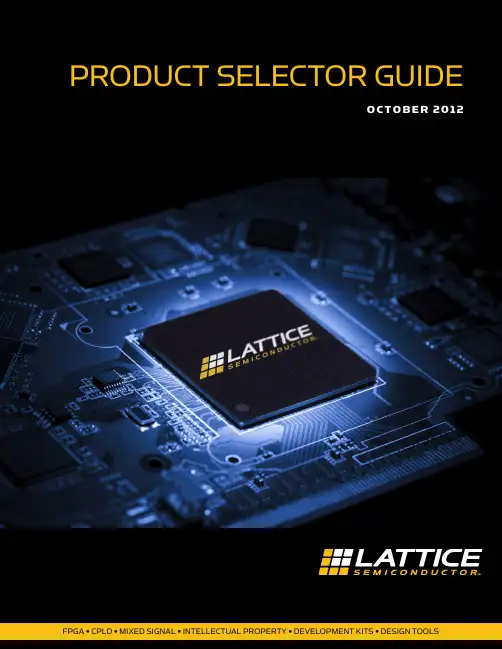
PRODUCT SELECTOR GUIDE2012FPGA • CPLD • MIXED SIGNAL • INTELLECTUAL PROPERTY • DEVELOPMENT KITS • DESIGN TOOLSCONTENTS■A dvanced Packaging (4)■F PGA Products (6)■CPLD Products (8)■Power Management and Clock Management Products (8)■Intellectual Property and Reference Designs (10)■Development Kits and Evaluation Boards (14)■P rogramming Hardware (18)■FPGA and CPLD Design Software (19)■PAC-Designer® Design Software (19)Page 2Affordable InnovationLattice Semiconductor is committed to delivering value through innovative low cost, low power solutions.We’re innovating every day to drive down costs and deliver greater value. From cost sensitive consumerelectronics to leading edge communications equipment, designers are using Lattice products in a growingnumber of applications. We’ve shipped over a billion devices to customers worldwide and we understandthat we must deliver cost effective solutions and excellent service in order to succeed.Low Density and Ultra-Low Density FPGAsWe are committed to providing design engineers with the low cost and low power solutions they needto implement their designs quickly, easily and affordably. Lattice FPGA solutions offer unique features,low power, and excellent value for FPGA designs. Our low density LatticeECP3™ family is comprisedof the lowest power, SERDES-enabled FPGAs in the market today, and is ideally suited for deploymentin high volume cost- and power-sensitive wireless and wireline infrastructure, video camera and displayapplications. Our ultra-low density, low cost and low power iCE40™ and MachXO2™ FPGA familiesare ideal for applications ranging from glue logic and bridging to instant-on system control and flexibleI/O expansion. From mobile handsets to leading-edge telecommunications infrastructure, Lattice offerssolutions that minimize cost and power while maximizing value.Power Management and Clock ManagementOur Platform Manager™, Power Manager II and ispClock™ mixed signal product families feature acombination of programmable logic and programmable analog circuitry that allows system designersto reduce system cost and design time. These innovative products provide a fast and easy solution forintegrating a wide range of power and clock management functions within a single integrated circuit. Theseproducts can replace numerous discrete components, reducing cost and conserving board space, whileproviding users with additional design flexibility and time-to-market benefits.Software and Intellectual PropertyOur Lattice Diamond® development tool suite, iCEcube2™ design software, PAC-Designer software, and IPcore program allow design engineers to easily customize our devices for their unique system requirements.Lattice Diamond software tools enable users to synthesize a design, perform analysis, debug, anddownload a logic configuration to our FPGA devices, while iCEcube2 software supports our iCE40 family ofFGPAs. PAC-Designer software is used in the design of our mixed signal products.Our IP core program, LatticeCORE™, provides pre-tested, reusable functions, allowing designers to focuson their unique system architectures. These IP cores provide industry-standard functions including PCIExpress, DDR, Ethernet, CPRI, Serial RapidIO 2.1, SPI4, and embedded microprocessors. In addition, anumber of independent IP providers have teamed with Lattice to offer additional high quality, reusable IPcores. Partners are selected for their industry leadership, high development standards, and commitment tocustomer support.Page 3Page 4Organic Flip Chip BGAFine Pitch BGA1704-BallOrganic fcBGA 42.5 x 42.5 mm 3.25 mm height 1.00 mm pitch1020-BallOrganic fcBGA Revision 233 x 33 mm 3.25 mm height 1.00 mm pitch1152-Ball fpBGA 1156-Ball fpBGA 35 x 35 mm 2.60 mm height 1.00 mm pitc h900-Ball fpBGA 31 x 31 mm 2.60 mm height 1.00 mm pitch672-Ball fpBGA 27 x 27 mm 2.60 mm height 1.00 mm pitch484-Ball fpBGA 23 x 23 mm 2.60 mm height 1.00 mm pitch324-Ball ftBGA 19 x 19 mm 1.70 mm height 1.00 mm pitch256-Ball ftBGA 17 x 17 mmOption 1: 1.55 mm height Option 2: 2.10 mm height Option 3: 1.70 mm height 1.00 mm pitch 256-Ball caBGA 14 x 14 mm 1.70 mm height 0.80 mm pitch332-Ball caBGA 17 x 17 mm 2.00 mm height 0.80 mm pitch208-Ball ftBGA 17 x 17 mm 1.55 mm height 1.00 mm pitch256-Ball fpBGA 17 x 17 mm 2.10 mm height1.00 mm pitchFine Pitch BGAChip Array BGANote: Packages shown actual size. Height specification is max.Page 5208-Pin PQFP 28 x 28 mm (body)4.10 mm height 0.50 mm pitch176-Pin TQFP 24 x 24 mm (body)1.60 mm height 0.50 mm pitch144-Pin TQFP 20 x 20 mm (body)1.60 mm height 0.50 mm pitch100-Pin VQFP 14 x 14 mm (body)1.2 mm height 0.50 mm pitch100-Pin TQFP 128-Pin TQFP 14 x 14 mm (body)1.6 mm height0.50 mm pitch (100 TQFP)0.40 mm pitch (128 TQFP )44-Pin TQFP10 x 10 mm (body)1.20 mm height 1.60 mm height 0.80 mm pitch 48-Pin TQFP 7 x 7 mm (body)1.20 mm height 1.60 mm height0.50 mm pitchVQFP/TQFP/PQFP64-Pin QFNS 9 x 9 mm1.00 mm height 0.50 mm pitch 100-Ball csBGA 8 x 8 mm1.35 mm height 0.50 mm pitch132-Ball csBG A 8 x 8 mmOption 1: 1.35 mm heightOption 2: 1.00 mm height (iCE40)0.50 mm pitch 184-Ball csBG A 8 x 8 mm1.35 mm height 0.50 mm pitch284-Ball csBGA 12 x 12 mm 1.00 mm height 0.50 mm pitch 328-Ball csBGA 10 x 10 mm 1.50 mm height 0.50 mm pitch 132-Ball ucBGA 6 x 6 mm1.00 mm height 0.40 mm pitch 25-Ball WLCSP2.5 x 2.5 mm 0.62 mm height 0.40 mm pitch84-Pin QFNS 7 x 7 mm1.00 mm height 0.50 mm pitch 48-Pin QFNS 7 x 7 mm1.00 mm height 0.50 mm pitch144-Ball csBGA 7 x 7 mm1.10 mm height 0.50 mm pitch 64-Ball ucBGA 4 x 4 mm1.00 mm height 0.40 mm pitch 32-Pin QFNS 5 x 5 mm1.00 mm height 0.50 mm pitch 32-Pin QFN 5 x 5 mm0.60 mm height 0.50 mm pitch 56-Ball csBGA 6 x 6 mm1.35 mm height 0.50 mm pitch 81-Ball csBGA 5 x 5 mm1.00 mm height 0.50 mm pitch 225-Ball ucBGA 7 x 7 mm1.00 mm height 0.40 mm pitch 24-Pin QFNS 4 x 4 mm1.00 mm height 0.50 mm pitch64-Ball csBGA 5 x 5 mm1.10 mm height 0.50 mm pitch121-Ball csBGA 6 x 6 mm1.00 mm height 0.50 mm pitch 121-Ball ucBGA 5 x 5 mm1.00 mm height 0.40 mm pitch 81-Ball ucBGA 4 x 4 mm1.00 mm height 0.40 mm pitch 49-Ball ucBGA 3 x 3 mm1.00 mm height 0.40 mm pitch 36-Ball ucBGA2.5 x 2.5 mm 1.00 mm height0.40 mm pitchQFNS / QFNChip Scale BGAUltra Chip Scale BGAWafer Level Chip ScaleNote: Packages shown actual size. Height specification is max.NEWiCE40™Page 6Page 71) Pb-free only.ispClock ProductsPage 8Platform Manager and Power Manager II Device Selector Guide* ispPAC-POWR1014A OnlyPage 9LatticeCORE IP CoresThe following is a partial listing of LatticeCORE IP, for a complete listing of IP cores from Lattice and its 3rd party partners, please go to /ip.1. LatticeSCM™ MACO®-based IP cores are not included in this table.Page 10IP SuitesLattice IP Suites provide many of the functions required to develop a total solution for common FPGA applications. In addition, multipleLattice FPGA families are supported with each IP Suite, so designers can develop solutions across multiple Lattice families, taking advantage of the best features of each. The following table summarizes which IP cores are included in each IP Suite, and which FPGA families are supported.Page 11Page 12Page 13Page 14Features- Power connections and power sources - ispVM™ programming support- On-board and external reference clock sources• Available on Windows and Linux platforms • Software and IP with a 60-day license (Windows or Linux)• Variety of demos • USB download cable• Comprehensive Image Processing IP Library • On-board Broadcom ® Broadreach™ PHY Enables IP over Coax• On-board FTDI Chip provides easy programming via low cost USB cable- Gigabit Ethernet MAC Demo using Mico32- DDR3 Memory Controller Demo• Available on Windows and Linux platforms • USB A to USB B (Mini) Cable for FPGA Programming via a PC• 12V AC Power Adapter and International Plug Adapters•QuickSTART GuideFeaturesFeaturesFeaturesLatticeECP3 Versa Development KitHDR-60 Video Camera Development KitLatticeECP3 PCI Express Development KitLatticeXP2 Brevia2 Development Kit• LatticeECP3 PCI Express x1/x4 Solutions Board- PCI Express x1 and x4 edge connector interfaces- On-board Boot Flash- Both Serial SPI Flash and Parallel Flash via MachXO programming bridge - Shows interoperation with a highperformance DDR2 memory component - Switches, LEDs, displays for demo purposes- Input connection for lab-power supply• FPGA-based Image Signal Processing• Fully Production-Ready HDR Camera Design • 1080p Capable @ 60 frames per second• Supports up to 16 Megapixel Sensors • Supports up to two sensors simultaneously • Full 60fps in streaming mode needs no external frame buffer• Fast Auto Exposure Instantly Adjust to Changing Light• Greater than 120 dB High Dynamic Range (HDR) Performance• Direct HDMI/DVI output from FPGA • Extremely Low-Latency• The LatticeECP3 Versa Evaluation Board:- PCI Express 1.1 x1 Edge Connector Interface- Two Gigabit Ethernet Ports (RJ45)- 4 SMA Connectors for SERDES Access - USB Mini for FPGA Programming- LatticeECP3 FPGA: LFE3-35EA-FF484- 64 Mbit Serial Flash memory - 1 Gbit DDR3 Memory- 14-segment alpha-numeric display - Switches and LEDs for demos - SERDES Eye Quality Demo - 4 PCI Express Demos• LatticeXP2 FPGA: LFXP2-5E-6TN144C • 2 Mbit SPI Flash Memory • 1 Mbit SRAM• Programmed via included mini-USB Cable • 2x20 and 2x5 Expansion Headers• Push buttons for General Purpose I/O and Reset• 4-bit DIP Switch for user-defined inputs • 8 Status LEDs for user-defined outputsDevelop PCIe-based platforms using a low-cost, low-power SERDES-basedFPGA with proprietary and Lattice provided designs.A fully production ready High Dynamic Range (HDR) camera, designed to fit into commercially available camera housings. Supports full 1080p resolution at 60 frames per second in streaming mode through the FPGA, without the need for an external frame buffer.Industry’s lowest cost platform for design-ing PCI Express and Gigabit Ethernet based systems. The kit includes free demos and reference designs.Easy-to-use, low-cost platform for evaluat-ing and designing with LatticeXP2 FPGAs.Page 15FeaturesFeaturesiCEblink40 Evaluation KitMachXO2 Pico Development KitMachXO2 Control Development Kit• Two versions:- High Performance: iCE40HX1K-VQ100 - Low Power: iCE40LP1K-QN84• Powered by USB input• 1Mbit SPI PROM (enough for two iCE40HX1K images using WarmBoot)• Four capacitive-touch buttons (requires FPGA logic)• Four user LEDs• Dual PMOD header compatible with Digilent PMOD boards (6x2 header)• MachXO2 LCMXO2-1200ZE• 4-character 16-segment LCD display • 4 capacitive touch sense buttons • 1 Mbit SPI Flash• I 2C temperature sensor• Current and voltage sensor circuits • Expansion header for JTAG, I 2C• Standard USB cable for device programming and I 2C communication• RS-232/USB & JTAG/USB interface• RoHS-compliant packaging and process• MachXO2 LCMXO2-4000HC• Power Manager II ispPAC-POWR1014A • 128Mbit LPDDR memory, 4Mbit SPI Flash • Current and voltage sensor circuits • SD memory card socket • Microphone• Audio Amplifier and Delta-Sigma ADC• Up to two DVI sources and one DVI output.• Up to two Display Inputs (7:1 LVDS) and one Display Output (7:1 LVDS)• Audio output channel• Expansion header for JTAG, SPI, I 2C and PLD I/Os.• 3.33 MHz oscillator (can be modified to support 33.33 MHz or 333 kHz)• 1.2V and 3.3V power supplies• All iCE40HX1K I/O available on headers or 0.1” through-holes• Watch battery• QuickSTART Guide• LEDs & switches• Standard USB cable for device programming • RS-232/USB & JTAG/USB interface• RoHS-compliant packaging and process • AC adapter (international plugs)• QuickSTART Guide31, 2012. Standard list price: $39.MachXO Control Development Kit FeaturesMachXO Pico Dev. Kit & MachXO Control Dev. Kit• Preloaded Control SoC Demo • MachXO LCMXO2280• Power Manager II ispPAC-POWR1014A• 2Mbit SPI Flash & 1Mbit SRAM • I 2C temperature sensor • Current and voltage sensor circuits • On-board fan • Interface to 16 x 2 LCD panel*• SD memory and Compact Flash memory card sockets*• Audio output channel• Expansion header for SPI & I 2C • LEDs & switches• Standard USB cable for device programming and I 2C communication • RS-232/USB & JTAG/USB interface • 3” x 1” prototyping area • RoHS-compliant packaging and process * LCD panel and SD/Compact Flash memory not included in the development kit MachXO Mini Development Kit Features• MachXO PLD: LCMXO2280C-4TN144C• 2 Mbit SPI Flash memory • 1 Mbit SRAM• I 2C temperature sensor • USB mini jack sockets for power, JTAG programming, and RS-232 debugging • 2X16 header for off-board expansion provides access to top and right side MachXO banks• Push-buttons for sleep mode and reset• 4-bit DIP switch to user-defined inputs • ADC/DAC circuit • Sleep circuit• 8 LEDs for user-defined outputs• RoHS-compliant packaging and process• Two USB connector cables • QuickSTART GuidePage 16FeaturesFeaturesFeaturesPower Manager II Hercules Development KitProcessorPM Development KitPlatform Manager Development Kit• The Standard Edition Hercules DevelopmentKit features the following:- Preloaded Board Digital ManagementDemo- Hercules Standard Edition eval board- Power Manager II ispPAC-POWR1220AT8 and MachXOLCMXO2280 PLD• The Advanced Edition Hercules DevelopmentKit features the following:- Preloaded Board Digital ManagementDemo- Hercules Advanced Edition evaluationboard with CompactPCI headers- Power Manager II ispPAC-POWR1220AT8 and MachXOLCMXO2280 PLD- Backplane accessory evaluation boardand power supply for live hot-swap• AC adapter (international plugs)• USB Connector Cable• RoHS-compliant packaging and process• Pre-configured Processor Support Demo• ProcessorPM-POWR605• Power Manager II POWR6AT6• 3.3V, 2.5V, and 1.8V supply rails• LEDs• Slide potentiometer• 2x14 expansion header• USB mini jack socket (program/power)• 2 Push-Buttons• Preloaded Power Management Demo• LPTM10-12107, Platform Manager, 208-ballftBGA package• 35mm slide pots to emulate supply railvariations• Pads for user I/O, LED, and switches• JTAG and I2C interface headers• USB Cable• 4-Bit DIP Switch• JTAG and I2C Header Landings• RoHS-compliant packaging and process• USB connector cable• QuickSTART Guide• AC adapter with international plugs• Programmable with ispVM System software• QuickSTART GuideVersatile, ready to use hardware platformsfor evaluating and designing with PowerManager II devices. A Standard and Ad-vanced Edition of each kit is available.Versatile, ready-to-use hardware platformfor evaluating and designing with Proces-sorPM power management devices.A versatile, ready-to-use hardware plat-form for evaluating and designing withPlatform Manager devices.Features:Breakout Board Evaluation Kits•Preprogrammed with hardware test programLCMXO2-1200ZE-1TG144C PLD (MachXO2Breakout Board), LCMXO2280C-FTN256CPLD (MachXO2280 Breakout Board),POWR1014A-02TN48I (POWR1014ABreakout Board), or LC4256ZE-TN144C CPLD(ispMACH 4256ZE Breakout Board)• LEDs•Expansion Header LandingsBreakout Board Evaluation Kits for selectMachXO2, MachXO, ispMACH 4000ZE,Power Manager II devices offer convenienthardware evaluations by providing easyhand-access to PLD I/Os.•Prototyping Area•USB Mini Jack Socket (Program/Power)•JTAG Header Landing•RoHS-compliant packaging and process•USB connector cableFeaturesispMACH 4000ZE Pico Development Kit• Pre-programmed Pico Power Demo• ispMACH 4000ZE device(LC4256ZE-5MN144C)• Power Manager II device(ispPAC-POWR6AT6-01SN32I)• LCD panel• USB mini jack socket for power, JTAGprogramming, and I2C interface• 2X15 header landing for off-board expansionprovides access to LC4256ZE GPIOs,POWR6AT6 VMON inputs, I2C, and JTAG chain• Push-button for global reset• 4-bit DIP switch to user-defined inputs• 3.3V and 2.5V supply rails• Current and voltage sensor circuits• Battery or USB power source• RoHS-compliant packaging and process• Marked for CE, China RoHS Environmental-Friendly Use Period (EFUP) and WasteElectrical and Electronic Equipment (WEEE)Directives• One USB connector cable• QuickSTART GuideBattery-powered, low-cost platform toaccelerate the evaluation of ispMACH4000ZE CPLDs.Page 17Programming HardwarePage 18PAC-Designer — Mixed-Signal Design SoftwarePage 19Technical SupportUSA & Canada: 1-800-LATTICE (528-8423)For other locations: +1-503-268-8001PLDTechnicalandSoftware:***************************MixedSignal:***********************Additionally, customers can receive technical support for Lattice’s Programmable Logic Products from our Asia based applications group, by contacting Lattice Asia applications during the hours of 8:30 a.m. to 5:30 p.m. Beijing Time (CST) +0800 UTC (Chinese and English language only).Asia: +86-21-52989090********************************Corporate HeadquartersLattice Semiconductor Corporation 5555 Northeast Moore CourtHillsboro, Oregon 97124-6421 USA Telephone: +1-503-268-8000Facsimile: +1-503-268-8347Web: Software LicensingEmail:************************Web: /licensing/index.cfmCopyright © 2012 Lattice Semiconductor Corporation. All brand names or product names are trademarks or registered trademarks of their respective holders. Lattice Semiconductor Corporation, L Lattice Semiconductor Corporation (logo), L (stylized), L (design), Lattice (design), Lattice Diamond, LSC, E 2CMOS, FlashBAK, flexiFLASH, flexiMAC, flexiPCS, FreedomChip, GAL, GDX, Generic Array Logic, HDL Explorer, iCE40, iCEblink, iCEcube2, IPexpress, ISP , ispATE, ispClock, ispDOWNLOAD, ispGAL, ispGDS, ispGDX, ispGDXV, ispGDX2, ispGENERATOR, ispJTAG, ispLeverCORE, ispLSI, ispMACH, ispPAC, ispTURBO, ispVIRTUAL MACHINE, ispVM, ispXP , ispXPGA, ispXPLD, LatticeCORE, LatticeECP3, LatticeECP2, LatticeECP2M, LatticeECP , LatticeECP-DSP , LatticeMico, LatticeMico8, LatticeMico32, LatticeSC, LatticeSCM, LatticeXP , LatticeXP2, MACH, MachXO, MachXO2, MACO, ORCA, PAC, PAC-Designer, PAL, Performance Analyst, Platform Manager, ProcessorPM, PURESPEED, Reveal, Silicon Forest, Speedlocked, Speed Locking, sysCLOCK, sysCONFIG, sysDSP , sysHSI, sysI/O, sysMEM, The Simple Machine for Complex Design, TransFR, UltraMOS, and specific product designations are either registered trademarks or trademarks of Lattice Semiconductor Corporation or its subsidiaries in the United States and/or other countries. ISP is a service mark of Lattice Semiconductor Corporation.October 2012 • Order #: I0211K。
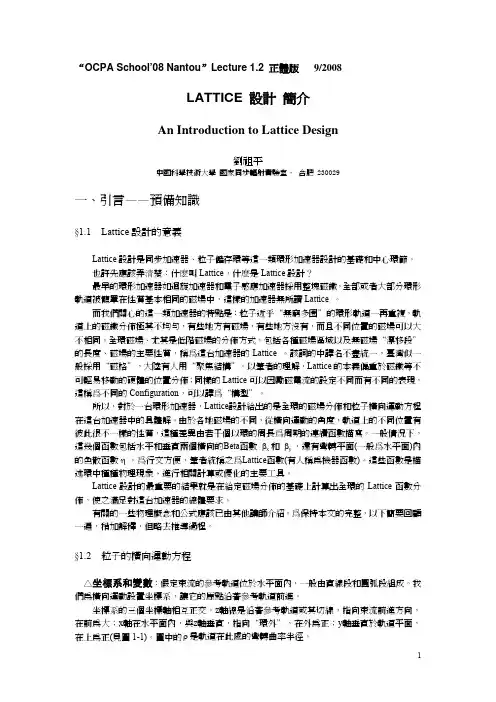

书本封面上有一只茶壶,茶壶的壶嘴和把手在同样一边,如果你倒茶,你很有可能就把自己烫伤。
诺曼告诉你,生活艰难,往往是「坏设计」惹的祸。
读懂交互,首先得读懂人对设计的需求。
正如乔布斯所说,设计不只是外表和感觉,设计是产品如何运作。
设计师的终极目的在于做出好用的产品,而不仅仅是好看。
2.《点石成金》Don’t Make Me T hink ——Steve Krug“这本书的特点,首先是短小精悍,200页的篇幅,一点都不会罗嗦,一个中午,或许临睡前,甚至在飞机上,上下班途中,你就有可能把它一口气读完(怕最有可能的是拿到书以后就爱不释手地读下去了)。
”其中讲Web可用性三大定律,第一条便是——别让我思考。
3.《写给大家看的设计书》T he Non-Designer’s Design Book ——Robin Williams交互设计师必须学习基本的排版知识,没有审美无法成为设计师。
在这个创意无处不在的时代,你必须让自己成为一名设计师。
在Robin Williams看来,设计其实很简单。
全书围绕C.R.A.P (对比、重复、对齐和亲密性)这四个原则,用简洁通俗、幽默生动的文笔讲述灵活地运用这些原则能够带来多大的改变和亲眼可见的好处。
除此之外,还科普了颜色与字体的一些基础知识,使得全书更加完整。
用户体验与UX进阶书籍1.《用户体验的要素》T he Elements of User Experience ——Jesse James Garrett如果你需要的是一本教你“怎样做(How-to-do)”的书,有很多很多讨论如何建设网站的书,这本不是;如果你需要的是一本关于技术的书,在这里你找不到一行代码;如果你想在这本书里找答案,相反,这本书说的是“如何提出正确的问题”。
这本书将告诉你,在你阅读其他书籍的之前,你需要提前了解什么。
如果你需要一个大的概念,如果你需要了解用户体验设计师所做出的决策的环境,这本书很适合你。
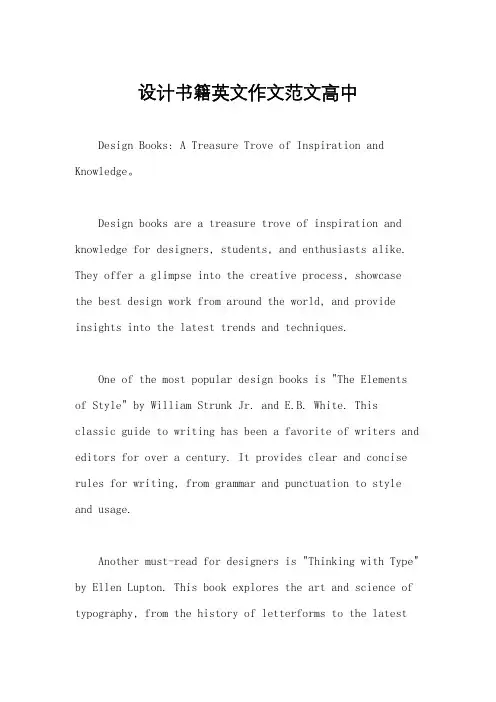
设计书籍英文作文范文高中Design Books: A Treasure Trove of Inspiration and Knowledge。
Design books are a treasure trove of inspiration and knowledge for designers, students, and enthusiasts alike. They offer a glimpse into the creative process, showcase the best design work from around the world, and provide insights into the latest trends and techniques.One of the most popular design books is "The Elements of Style" by William Strunk Jr. and E.B. White. Thisclassic guide to writing has been a favorite of writers and editors for over a century. It provides clear and concise rules for writing, from grammar and punctuation to style and usage.Another must-read for designers is "Thinking with Type" by Ellen Lupton. This book explores the art and science of typography, from the history of letterforms to the latestdigital techniques. It is a comprehensive guide to the design and use of type, and includes practical tips and examples.For those interested in graphic design, "The Non-Designer's Design Book" by Robin Williams is a great place to start. This book introduces the basic principles of design, such as contrast, alignment, and proximity, and shows how they can be applied to create effective designs. It also covers topics such as color theory, typography, and layout."Designing Brand Identity" by Alina Wheeler is an essential resource for anyone involved in branding and marketing. This book covers everything from creating a brand strategy to designing a logo and developing a brand voice. It includes case studies and examples from some of the world's most successful brands."Interaction of Color" by Josef Albers is a groundbreaking book on color theory and perception. It explores how colors interact with each other and how theycan be used to create different moods and effects. It includes exercises and experiments that allow readers to explore color for themselves.Finally, "The Design of Everyday Things" by Don Norman is a classic book on user-centered design. It explores how people interact with everyday objects and how design can make them more usable and enjoyable. It covers topics such as affordances, feedback, and mental models.In conclusion, design books are an invaluable resource for anyone interested in design. They offer a wealth of knowledge and inspiration, and can help designers improve their skills and stay up-to-date with the latest trends and techniques. Whether you are a student, a professional designer, or simply an enthusiast, there is a design book out there for you.。

设计书籍英文作文英文:When it comes to designing a book, there are several things to consider. First and foremost, the cover design is crucial. A book cover is the first thing a potential reader sees, and it needs to be eye-catching and memorable. Thetitle and author name should also be prominent and easy to read.Another important aspect of book design is the layout. The text should be easy to read, with appropriate font size and spacing. Chapter headings and subheadings should be clearly defined, and any images or illustrations should be placed strategically throughout the book.In addition, the overall design should reflect the tone and content of the book. For example, a book about aserious topic may have a more subdued color scheme and font, while a book aimed at children may have bright colors andplayful illustrations.中文:设计一本书时,有几个方面需要考虑。
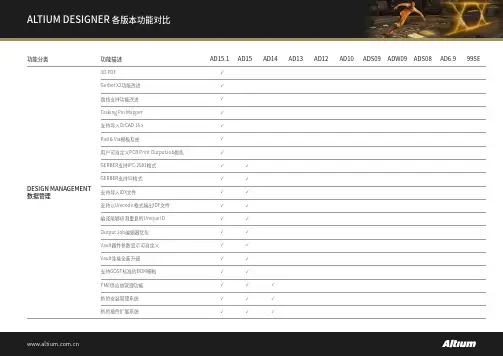

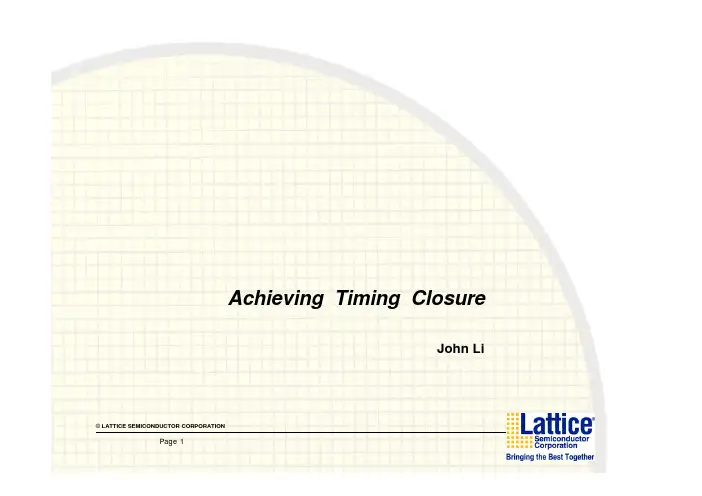
©LATTICE SEMICONDUCTOR CORPORATIONPage 1Achieving Timing ClosureJohn LiAgenda•Timing closure的概念•Timing closure的步骤•采用合适的Coding Style •进行适当的综合约束•管脚锁定•实施Lattice constrains •Map•布局布线•控制place and route •Floorplanning the design©LATTICE SEMICONDUCTOR CORPORATIONPage 2Timing closure的概念•当前FPGA的设计规模越来越大,复杂程度日益增加,同时要求系统的Perfromace也越来越高。
•获得Timing目标越来越困难.•设计者必须采用各种技术提升系统性能以满足设计的Timing要求.©LATTICE SEMICONDUCTOR CORPORATIONPage 3Timing closure procedure• 1.采用合适的coding style • 2.进行适当的综合约束• 3.管脚锁定• 4.实施Lattice constrains • 5.Map• 5.布局布线•7.控制place and route •8.Floorplanning the design©LATTICE SEMICONDUCTOR CORPORATIONPage 4关于提升FPGA系统性能,工程师最容易想到的方法就是通过进行综合约束、布局布线约束、和其他的优化技术提升系统性能,当然这些都是设计过程中所必需的,但所有这些优化方法对于系统性能的提升都是有限的,系统的性能最终还是取决于工程师的设计(coding style),其中同步设计是最重要的一点. 下面讨论一些具体的coding 技术,合理的运用这些coding技术能够尽可能的减小两级寄存器之间的延时从而获得更高的系统速度.-通用的coding style--Hierarchical Coding---Team Based的设计:多个工程师可以同时参与到一个复杂设计中来。

设计书籍英文作文素材英文:Designing a book is a complex and creative process that requires attention to detail and a deep understanding of the subject matter. As a writer, I know firsthand the importance of a well-designed book in capturing thereader's attention and conveying the intended message.One of the key elements of book design is the cover. A book cover should be eye-catching and visually appealing, while also conveying the tone and content of the book. For example, if I were designing a book about travel, I might choose a cover image of a beautiful landscape or an iconic landmark to draw the reader in.Another important aspect of book design is the layout. The layout should be easy to read and visually appealing, with appropriate use of font, spacing, and images. For example, if I were designing a cookbook, I would make sureto include plenty of high-quality photos of the dishes, along with clear and easy-to-follow instructions.In addition to the cover and layout, book design also involves decisions about paper quality, binding, and other physical attributes. These details may seem small, but they can have a big impact on the overall reading experience.Overall, designing a book is a challenging but rewarding process that requires a combination of creativity and attention to detail. A well-designed book can make all the difference in capturing the reader's attention and conveying the intended message.中文:设计一本书是一个复杂而富有创意的过程,需要关注细节并对主题有深入的了解。
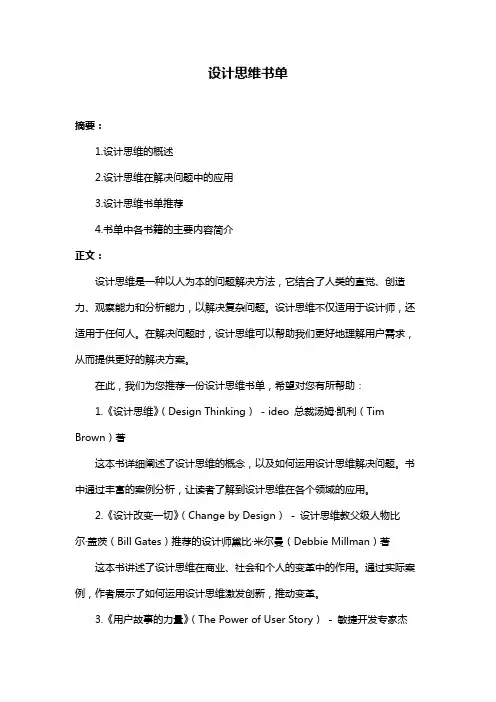
设计思维书单摘要:1.设计思维的概述2.设计思维在解决问题中的应用3.设计思维书单推荐4.书单中各书籍的主要内容简介正文:设计思维是一种以人为本的问题解决方法,它结合了人类的直觉、创造力、观察能力和分析能力,以解决复杂问题。
设计思维不仅适用于设计师,还适用于任何人。
在解决问题时,设计思维可以帮助我们更好地理解用户需求,从而提供更好的解决方案。
在此,我们为您推荐一份设计思维书单,希望对您有所帮助:1.《设计思维》(Design Thinking)- ideo 总裁汤姆·凯利(Tim Brown)著这本书详细阐述了设计思维的概念,以及如何运用设计思维解决问题。
书中通过丰富的案例分析,让读者了解到设计思维在各个领域的应用。
2.《设计改变一切》(Change by Design)- 设计思维教父级人物比尔·盖茨(Bill Gates)推荐的设计师黛比·米尔曼(Debbie Millman)著这本书讲述了设计思维在商业、社会和个人的变革中的作用。
通过实际案例,作者展示了如何运用设计思维激发创新,推动变革。
3.《用户故事的力量》(The Power of User Story)- 敏捷开发专家杰夫·萨瑟兰(Jeff Sutherland)著这本书介绍了用户故事在设计思维中的应用,以及如何通过用户故事更好地了解用户需求,为产品设计提供指导。
4.《设计原则》(Principles of Design)- 设计大师保罗·兰德(Paul Rand)著这本书详细阐述了设计原则的概念和运用,为设计师提供了一套系统的设计方法。
虽然这本书主要针对设计师,但其原则同样适用于其他领域。
5.《洞察力》(Insightful)- 心理学家和教育学家乔治·罗文斯坦(George Lowenstein)著这本书从心理学的角度分析了人类在解决问题时的洞察力,以及如何运用洞察力进行创新设计。
Lattice ispMACH TM 4000V/B/C/Z 设计指南及常见问题解答目录1介绍 (4)1.1特征 (4)1.2产品系列和器件选择手册 (4)1.3性能分析 (5)1.3.1超快性能 (5)1.3.2最低功耗 (6)2体系结构概述 (7)2.1ISP MACH4000体系结构 (7)2.2结构特征 (9)2.2.1逻辑分配器和3种速度路径 (9)2.2.2带可编程延时的输入寄存器 (10)2.2.3灵活的时钟和时钟使能 (10)2.2.4初始化控制 (11)2.2.5ORP BYPASS多路复用器 (11)2.2.6I/O 单元 (12)2.2.7OE 控制 (12)3设计实现 (13)3.1全局约束 (13)3.1.1Fitter 选项 (13)3.1.2利用率选项 (14)3.2约束编辑器 (15)3.2.1设备设置表 (15)3.2.2封装察看/引脚编辑规划 (15)3.2.3引脚/节点位置分配 (16)3.2.4组分配 (16)3.2.5I/O类型设置 (16)3.2.6资源预留 (17)3.2.7缺省设置 (17)3.3资源约束 (17)3.3.1使用源约束注意事项 (17)3.3.2源约束语法 (18)3.4优化设计方法 (21)3.4.1ispLEVEL 约束选项控制 (21)3.4.2HDL 源文件约束控制 (22)4器件应用要点 (22)4.14K系列器件VCC和VCCO的作用和连接 (22)4.24K系列器件各电源上电时间及要求 (22)4.34K系列器件的全局复位 (22)4.4关于4K系列器件时钟的用法 (22)4.5全局输出使能信号 (23)4.6CPLD的I/O口作为双向口使用时应注意的问题 (23)4.7关于设计中使用宽多路复用器的问题 (24)4.8未使用引脚的处理 (25)4.9I/O5V兼容问题 (25)4.10I/O口的电平设置 (25)4.114K系列器件引脚上、下拉电阻,OD,慢摆率特性的设定 (25)4.12关于引脚的缺省值和更改 (27)4.134K系列器件功耗的计算 (27)4.144K系列器件节点温度的计算 (27)4.154K器件的热插拔 (28)4.16ISP JTAG编程/测试信号 (28)4.17CPU加载的频率 (28)4.184K系列器件可承受的加载次数 (28)4.19加载过程中I/O口的状态 (28)4.20综合工具的选择 (29)4.21关于约束文件 (29)4.22用嵌入的M ODEL S IM 仿真 (29)4.23M ODEL S IM应用点滴 (30)4.244K器件上电电压阀值 (30)4.25ISP LEVER中的版本控制功能 (31)4.26ISP LEVER中C ONSTRAINT E DITOR的G LOBAL C ONSTRAINTS设置 (32)4.27ISP LEVER中的时序分析 (33)5ISPLEVER优化参数快速指南 (33)5.1ISP LEVER常用约束优化参数的含义与推荐设置 (33)5.2ISP LEVER推荐的优化参数设置 (35)6ISPLEVER安装说明 (36)6.1ISP LEVER安装说明 (36)6.2ISP VM S YSTEM安装说明 (37)7相关资料 (37)1介绍ispMACH4000 器件包括3.3V、2.5V和1.8V三个系列。
Lattice MachXO TM设计指南v1.11.介绍 (4)1.1特征 (4)1.2产品系列和器件选择手册 (5)1.3性能分析 (6)2.体系结构 (7)2.1M ACH XO结构概述 (7)2.1.1PFU结构 (7)2.1.2Slice结构 (8)2.1.3布线资源 (9)2.2结构特征 (9)2.2.1时钟/控制信号网络 (9)2.2.2锁相环PLL (10)2.2.3片内时钟振荡器 (11)2.2.4嵌入块RAM (EBR) (11)2.2.5I/O特性 (11)2.2.6休眠模式 (13)2.2.7器件编程 (13)3.设计综合&实现 (14)3.1开发流程 (14)3.2设置约束项 (16)3.2.1设置I/O位置 &属性 (16)3.2.2设置时钟频率|周期 (16)3.2.3设置建立&保持时间 (17)3.2.4设置Tco时间 (19)3.2.5设置MutiCycles | MaxDelay | Tpd (20)3.2.6时序约束例外(BLOCK) (20)3.2.7信号分组 (20)4.器件应用要点 (21)4.1M ACH XO系列器件V CC,V CCAUX,V CCIO作用和连接 (21)4.2M ACH XO系列器件各电源上电顺序及要求 (21)4.3M ACH XO热插拔应用注意事项 (21)4.4如何使用全局复位功能 (22)4.5如何使用全局输出三态功能 (22)4.6如何使用全局时钟 (23)4.7如何使用TFR功能(透明现场升级) (23)4.8如何使用M ACH XO的差分信号 (24)4.9如何接口5V输入信号 (25)4.10如何在同一B ANK使用不同I/O口电平标准 (25)4.11如何减小T CO时间 (26)4.12什么-M速度级别? (27)4.13如何获得时序分析结果? (27)4.14如何知道资源利用率 (28)4.15如何使用M ACH XO的块RAM(EBR) (28)4.16如何利用PFU生成移位寄存器和分布式RAM (29)4.17如何使用锁相环(PLL) (30)4.18下载接口(TAP)的连接建议 (30)4.19如何设置加密位和用户代码 (30)4.20如何使用P OWER C ACULTOR估计功耗 (31)4.21如何快速建立器件原理图库? (32)4.22如何选择综合工具? (32)4.23关于约束文件 (32)4.24如何使用M ODELSIM 进行仿真 (33)5.相关资料 (33)1.介绍MachXO器件是 Lattice 公司基于FLASH+SRAM技术CPLD器件。
数学专业英语词汇(L)l distribution l分布l function l函数l integral勒贝格积分l measurable function勒贝格可测函数l null set l零集l'hospital rule洛必达规则labeled graph标号图labile不稳定的laboratory system of coordinates实验室坐标系labyrinth迷宫lacation principle介值定理lacunarity缺项性lacunary series间隙级数lacunary space缺项空间lag延迟lag correlation滞后相关lag correlation coefficient滞后相关系数lag covariance落后协方差lag of phase相位滞后lag regression落后回归lagrange bracket拉格朗日括号lagrange equation of motion拉格朗日运动方程lagrange interpolation formula拉格朗日插置公式lagrange interpolation polynomial拉格郎日插值多项式lagrange multiplier拉格朗日乘子lagrange problem拉格朗日问题lagrange remainder term拉格朗日剩余项lagrange residual term拉格朗日剩余项lagrange theorem拉格朗日定理lagrangian拉格朗日算子lagrangian function拉格朗日算子lagrangian operator拉格朗日算符laguerre differential equation拉盖尔微分方程laguerre function拉盖尔函数laguerre polynomial拉盖尔多项式lambert series兰伯特级数lame equation拉梅方程lame function拉梅函数laminar薄层的laminar flow层流片流landau symbol兰道记号landen transformation兰登变换language of formula公式语言laplace beltrami operator拉普拉斯贝尔特拉米算子laplace distribution拉普拉斯分布laplace equation拉普拉斯方程laplace expansion拉普拉斯展开laplace expansion theorem拉普拉斯展开定理laplace integral拉普拉斯积分laplace linear equation拉普拉斯线性方程laplace transform拉普拉斯变换laplacian拉普拉斯算子laplacian equation拉普拉斯方程large sample analysis大样本分析large sample test大样本检验last multiplier最后乘子last term末项latency潜在latent潜在的lateral横的lateral area侧面积lateral surface侧面latin cube拉丁立方latin rectangle拉丁矩形latin square拉丁方latitude纬度lattice格子;格lattice constant点阵常数lattice design格子设计lattice distribution格分布lattice function点阵函数lattice isomorphism格同构lattice matrix点阵矩阵lattice of sets集格lattice operation格运算lattice ordered group格序群lattice point at the boundary边界格点lattice theoretic格论的lattice theory格论latticehomomorphism格同态latus rectum通径laue's equations劳卮方程laurent series罗郎级数law法则law of commutation交换律law of composition合成律law of cosines余弦定律law of deduction演绎定律law of double negation双重否定律law of errors误差律law of excluded middle排中律law of exponentiation指数定律law of inertia惯性律law of iterated logarithm迭对数定律law of large numbers大数定律law of similarity transformation相似变换律law of sines正弦定律law of small numbers小数定律law of tangents正切定律laws of integral exponents整指数定律leading coefficient首项系数leading diagonal衷角线leading ideal猪想leading term知项leaf叶least common denominator最小公分母least common left multiple左最小公倍数least common multiple最小公倍数least common right multiple右最小公倍数least significant digit最小有效数字least squares approximation最小二乘逼近least squares estimator最小二乘估计量least upper bound最小上界lebesgue area勒贝格面积lebesgue decomposition勒贝格分解lebesgue integrable勒贝格可积的lebesgue integral勒贝格积分lebesgue measurable勒贝格可测的lebesgue measure勒贝格测度lebesgue number勒贝格数lebesgue space勒贝格空间lebesgue stieltjes integral勒贝格斯蒂尔吉斯积分left adjoint左伴随的left adjoint homomorphism左伴随同态left almost periodic function左殆周期函数left alternative division ring左交错可除环left alternative law左交错律left alternative ring左交错环left annihilator左零化子left artinian ring左阿廷环left associated element左相伴元素left balanced functor左平衡函子left closed object在闭对象left completion左完备化left continuous左方连续的left continuous function左连续函数left coset左陪集left coset space左傍系空间left derivative左导数left derived functor左导函子left differential左微分left direct product左直积left directed quasiorder逆有向拟序left distributive左分配的left distributive law左分配律left divisor左因子left end point左端点left exact functor左正合函子left exactness左正合性left faithful functor左一一的函子left hand differentiable function左可微函数left hand lower dini derivative左下狄尼导数left hand side左边left hand symmetrizable kernel左方可对称化核left hand upper dini derivative左上狄尼导数left handed co ordinate system左手坐标系left handed curve左旋曲线left handed system左手坐标系left hereditary ring左遗传环left homotopy inverse左同伦逆元left ideal左理想left identity element左幺元left injective dimension左内射维数left inner product左内积left invariant mean左不变平均值left invariant measure左不变测度left inverse左逆的left inverse element左逆元left inverse matrix左逆阵left inverse operator左逆算子left invertible element左可逆元left invertible mapping左可逆映射left isolated point左孤立点left kernel左核left length左长left limit value左极限值left linear topology左线性拓扑left localization左局部化left mean左平均left module左模left monotonicity左单翟left multiplication ring左乘环left noetherian semigroup左诺特半群left non zerodivisor左非零因子left operator左算子left order左整环left periodic group左周期群left primitive ideal左本原理想left primitive ring左本原环left projective space左射影空间left quasi inverse左拟逆元left quasi regularity左拟正则性left quasi simple ring左拟单环left quasigroup左拟群left quotient左商left quotient field左商域left quotient ring左商环left radical左根基left regular element左正则元素left regular representation左正则表示left regularity左正则性left remainder左剩余left representation左表示left resolution左分解left satellite左卫星函子left semihereditary ring左半遗传环left semilinear mapping左半线性映射left side contiuous function左连续函数left side derivative左导数left side half open interval左半开区间left side limit value左极限值left sided decomposition左分解left simple groupoid左单广群left simple semigroup左单半群left tensor product左张量乘积left topology左拓扑left translation左平移left zero divisor左零因子leg of a right triangle直角三角形的侧边legendre function勒让德函数legendre polynomial勒让德多项式legendre relation勒让德关系legendre symbol勒让德记号legendre transform勒让德变换leibniz series莱布尼兹级数leibniz theorem莱布尼兹定理lemma引理lemniscate双纽线lemniscate function双纽线函数lemniscate of bernoulli伯努利双纽线length长度length of arc弧长length of curve曲线的长length of normal法线的长length of queue队列长度length of tangent切线的长length of vector向量的长length unit长度单位lens透镜lens space透镜空间leptokurtic distribution尖峰态分布less than or equal小于或等于letter文字level水准level curve阶层曲线level line等高线level plane水准面level surface等位面lever杠杆levi decomposition列维分解levi problem列维问题lexicographic词典的lexicographic order字典顺序liapunov function李雅普诺夫函数library厍library subroutine库存子程序lie algebra李代数lie continuous group李连续群lie derivative李导数lie group李群lie homomorphism李同态lie ring李环lie series李级数lie subring李子环life insurance寿命保险life table死亡率表life time生存时间lifting提升lifting map提升映射lifting theorem提升定理like term同类项likelihood似然likelihood function似然函数likelihood ratio似然比likelihood ratio test似然比值检验limacon of pascal帕斯卡蚶线limes inferior下极限limes superior上极限limit极限limit case极限情况limit circle极限圆limit circle type极限圆型limit cycle极限环limit distribution极限分布limit element极限元limit function极限函数limit in the sense of pointwise convergence点态收敛极限limit of efficiency有效极限limit of error误差限度limit of integration积分极限limit of proportionality比例极限limit on the left左极限limit on the right右极限limit ordinal number极限序数limit point极限点limit point type极限点型limit relation极限关系limit theorem极限定理limit theorem in probability theory概率论极限定理limit value极限值limitation限制limited有界的limited function有界函数limiting cone极限锥limiting distribution极限分布limiting point极限点limiting position极限位置limitless无界的limits of integration积分限line线line at infinity无穷远线line bundle线丛line coordinates线坐标line critical graph线临界图line element线素line graph线图line integral线积分line of curvature曲率线line of discontinuity不连续线line of horizon水平线line of intersection交线line of nodes交点线line of steepest descent最速下降线line of vector向量线line segment线段linear线的linear acceleration线性加速度linear algebra线性代数linear approximation线性近似linear approximation problem线性逼近问题linear associative algebra线性结合代数linear closure线性闭包linear combination线性组合linear convergence线性收敛linear density线密度linear dependence线性关系linear difference equation线性差分方程linear differential equation线性微分方程linear differential equation with constant coefficients常系数线性微分方程linear dimension线性维数linear eigenvalue problem线性特盏问题linear equation线性方程linear extrapolation线性外插linear form线性形式linear fractional function单应函数linear fractional transformation线性分式变换linear function线性函数linear functional线性泛函linear genus线性狂linear group线性群linear homogeneous equation线性齐次方程linear hull线性闭包linear independence线性无关linear integral equation线性积分方程linear integral equation of the third kind第三种线性积分方程linear interpolation线性插值linear isomorphism线性同构linear manifold线性廖linear map线性映射linear measure线性测度linear operator线性算子linear optimization线性最优化linear optimization problem线性最优化问题linear order线性有序类linear orderedness线性次序linear ordinary differential equation线性常微分方程linear pencil线性束linear programming线性规划linear quotient optimization线性商最优化linear regression线性回归linear relationship线性关系linear space线性空间linear subspace线性子空间linear subsystem线性子系linear system线性系linear system of curves线性曲线系linear system of differential equations线性微分方程系linear transformation线性变换linear vector function线性向量函数linear velocity线速度linearity线性linearization线性化linearly dependent set线性相关集linearly dependent system线性相关集linearly independent set线性无关系linearly independent system线性无关系linearly ordered class线性有序类linearly ordered set线性有序集link group连接群liouville number刘维尔数liouville theorem刘维尔定理lipschitz condition李普希茨条件lipschitz constant李普希茨常数lipschitz continuity李普希茨连续性lipschitz continuous function李普希茨连续函数lipschitz space李普希茨空间listing knot8字纽结liter升literal constant文字常数literal expression文字式litre升lituus连锁螺线load载荷load curve载荷曲线lobachevski space双曲空间lobachevskian geometry双曲几何学local arcwise connectedness局部弧连通性local base局部基local betti group局部贝蒂群local borel set局部波莱尔集local class field theory局部类域论local compactness局部紧性local condition局部条件local continuity局部连续性local convergence局部收敛local coordinate system局部坐标系local degree局部次数local degree of map局部映射度local extremum局部极值local group局部群local isomorphism局部同构local lie group局部李群local limit theorem局部极限定理local lipschitz condition局部李普希茨条件local maximum局部极大local minimum局部极小local parameter局部参数local property局部性质local ring局部环local ringed space局部环式空间local uniformization局部单值化local uniformizing局部单值化localization局部化localization principle局部化原理localizing subcategory局部化子范畴locally analytic function局部解析函数locally arcwise connected space局部弧连通空间locally bounded function局部有界函数locally closed set局部闭集locally compact mapping局部紧映射locally compact space局部紧空间locally connected continuum局部连通连续统locally connected set局部连通集locally connected space局部连通空间locally constant function局部常值函数locally constant sheaf局部常数层locally contractible space局部可缩空间locally convex algebra局部凸代数locally convex space局部凸空间locally convex topology局部凸拓扑locally euclidean connection局部欧几里得联通locally euclidean group局部欧几里得群locally euclidean manifold局部欧几里得廖locally euclidean space局部欧几里得空间locally finite category局部有限范畴locally finite complex局部有限复形locally finite family of sets局部有限集族locally finite graph局部有限图locally finite sum局部有限和locally flat局部平坦的locally free sheaf局部自由层locally homomorphic function局部同态函数locally pathconnected space局部道路连通空间locally regular confidence region局部正则置信区域locally separable space局部可分空间locally soluble group局部可解群locally trivial embedding局部平凡嵌入locally unbiased test局部无偏检验locally uniformizing parameter局部单值化参数locally uniformly convergent sequence局部一致收敛序列locally zero function局部零函数location存储单元location parameter位置参数location principle介值locus轨迹log curve对数曲线log log paper重对数坐标纸logarithm对数logarithm table对数表logarithm to the base10常用对数logarithm to the basese讷代对数logarithmic对数的logarithmic branchpoint对数分歧点logarithmic convexity对数凸性logarithmic coordinates对数座标logarithmic curve对数曲线logarithmic decrement对数衰减logarithmic derivative对数导数logarithmic distribution对数分布logarithmic equation对数方程logarithmic function对数函数logarithmic integral对数积分logarithmic normal distribution对数正态分布logarithmic paper对数坐标纸logarithmic potential对数位势logarithmic residue对数残数logarithmic scale对数尺度logarithmic series对数级数logarithmic singularity对数奇点logarithmic slide rule对数计算尺logarithmic spiral对数螺线logarithmic table对数表logic逻辑logic calculus逻辑学logic of pocket calculator袖珍计算机的逻辑logic of relations关系逻辑logic product合取logic sum析取logical逻辑的logical circuit逻辑电路logical comparison逻辑比较logical diagram逻辑图logical element逻辑元件logical operation逻辑运算logical paradox逻辑悖论logical shift逻辑移位logical symbol逻辑符号logical variable逻辑变量logically true proposition逻辑地真命题logicism逻辑皱logico mathematical model逻辑数学模型logistic暹辑斯谛logistic curve逻辑斯谛曲线logistic system形式系统lognormal distribution对数正态分布longitude经度longitudinal经度的longitudinal axis纵向轴loop闭路loop of a curve曲线的闭路loop space圈空间lopology of the uniformity一致拓扑lorentz group洛伦茨群lorentz transformation洛伦茨变换loss损失loss function损失函数loss system损失系统lot一批lot tolerance fraction defective批容许废品率low of cosines余弦定律lower approximate limit下近似极限lower bound下界lower central series降中心列lower class下类lower control limit下控制界限lower darboux integral达布下积分lower darboux sum达布下和lower density下密度lower dini derivative狄尼下导数lower envelope下包络lower half plane下半平面lower integral下积分lower limit下限lower limit of integration积分的下极限lower measure内测度lower order低位lower pure value下方值lower quartile第一四分位数lower semi modular lattice下半模格lower semicontinuity下半连续性lower semicontinuous decomposition下半连续分解lower semicontinuous function下半连续函数lower semilattice下半格lower sum下和lower triangular matrix下三角形矩阵lower value下方值lower variation负变差lowest common denominator最小公分母lowest common multiple最低公倍数lowest term最低项loxodrome斜驶曲线loxodromic matrix斜驶矩阵loxodromic spiral斜驶曲线loxodromic transformation斜驶变换lozenge diagram菱形图形lune弓形。
关于界面设计的书籍-回复关于界面设计的书籍一直以来都是让设计师们感兴趣的话题。
在这篇文章中,我将为你介绍一些关于界面设计的经典必读书籍,这些书籍将帮助你深入了解界面设计的基本原理、设计流程和最佳实践。
1. 《界面设计模式》(Interface Design Patterns)- 作者:Tal Mishali 这本书是一本关于界面设计模式的权威指南。
作者通过详细解释和示范不同的界面设计模式,帮助读者学习如何创建出具有良好用户体验的界面设计。
书中列举了大量实例,让你对界面设计模式有更深入的理解。
2. 《界面设计的心理学》(The Psychology of Interface Design)- 作者:John Morkes这本书着重介绍了心理学在界面设计中的应用。
作者通过研究用户行为、认知过程和视觉感知等心理学领域的知识,帮助读者了解用户行为背后的原理,并将这些原理应用到界面设计中。
通过阅读这本书,你将更好地理解用户的需求和期望,并能够根据其心理特点来设计出更具吸引力和易用性的界面。
3. 《交互设计实践》(The Practice of Interaction Design)- 作者:Alan Cooper这本书被誉为交互设计的圣经之一。
作者讲解了交互设计的核心概念和方法,包括用户研究、需求分析、设计原则和评估等。
这本书对于理解用户中心设计的重要性以及如何创建出符合用户期望的界面设计非常有帮助。
4. 《界面设计模式之美》(The Design of Everyday Things)- 作者:Don Norman这本书是一本经典的设计书籍,不仅适用于界面设计师,也适用于任何设计领域的从业者。
作者解释了为什么一些设计好看的界面却很难使用,以及如何通过遵循设计原则来创建出更人性化的界面。
这本书提供了大量实例,指导读者如何避免常见的设计错误,同时提供了改进设计的方法和技巧。
5. 《程序员的界面心理学》(Designing Interfaces)- 作者:Jenifer Tidwell这本书是一本针对程序员和开发者的界面设计指南。
第一章可编程逻辑技术简介第1章 可编程逻辑技术简介本章主要带领初学者了解一般性可编程设计技术。
本章在引入FPGA/CPLD基本概念的基础上,重点论述了FPGA/CPLD的完整设计流程,并对FPGA/CPLD常用开发工具加以简介,最后展望了FPGA/CPLD设计技术的新发展。
本章主要内容如下:•可编程逻辑设计技术简介;•FPGA/CPLD的基本结构;•FPGA/CPLD的设计流程;•FPGA/CPLD的常用开发工具;•下一代可编程逻辑设计技术展望。
1.1 可编程逻辑设计技术简介本节在讨论可编程逻辑器件发展简史的基础上简述目前常用的可编程逻辑器件的分类。
1.1.1 可编程逻辑器件发展简史随着微电子设计技术与工艺的发展,数字集成电路从电子管、晶体管、中小规模集成电路、超大规模集成电路(VLSIC)逐步发展到今天的专用集成电路(ASIC)。
ASIC的出现降低了产品的生产成本,提高了系统的可靠性,缩小了设计的物理尺寸,推动了社会的数字化进程。
但是ASIC因其设计周期长,改版投资大,灵活性差等缺陷制约着它的应用范围。
硬件工程师希望有一种更灵活的设计方法,根据需要,在实验室就能设计、更改大规模数字逻辑,研制自己的ASIC并马上投入使用,这是提出可编程逻辑器件的基本思想。
可编程逻辑器件随着微电子制造工艺的发展取得了长足的进步。
从早期的只能存储少量数据,完成简单逻辑功能的可编程只读存储器(PROM)、紫外线可擦除只读存储器(EPROM)和电可擦除只读存储器(E2PROM),发展到能完成中大规模的数字逻辑功能的可编程阵列逻辑(PAL)和通用阵列逻辑(GAL),今天已经发展成为可以完成超大规模的复杂组合逻辑与时序逻辑的复杂可编程逻辑器件(CPLD)和现场可编程逻辑器件第1章 可编程逻辑技术简介2 (FPGA )。
随着工艺技术的发展与市场需要,超大规模、高速、低功耗的新型FPGA/CPLD 不断推陈出新。
新一代的FPGA 甚至集成了中央处理器(CPU )或数字处理器(DSP )内核,在一片FPGA 上进行软硬件协同设计,为实现片上可编程系统(SOPC ,System On Programmable Chip )提供了强大的硬件支持。
1.1.2 可编程逻辑器件分类广义上讲,可编程逻辑器件是指一切通过软件手段更改、配置器件内部连接结构和逻辑单元,完成既定设计功能的数字集成电路。
目前常用的可编程逻辑器件主要有简单的逻辑阵列(PAL/GAL )、复杂可编程逻辑器件(CPLD )和现场可编程逻辑阵列(FPGA )等3大类。
(1) PAL/GALPAL 是Programmable Array Logic 的缩写,即可编程阵列逻辑;GAL 是Generic Array Logic 的缩写,即通用可编程阵列逻辑。
PAL/GAL 是早期可编程逻辑器件的发展形式,其特点是大多基于E 2CMOS 工艺,结构较为简单,可编程逻辑单元多为与、或阵列,可编程单元密度较低,仅能适用于某些简单的数字逻辑电路。
虽然PAL/GAL 密度较低,但是它们一出现即以其低功耗、低成本、高可靠性、软件可编程、可重复更改等特点引发了数字电路领域的巨大振动。
虽然目前较复杂的逻辑电路一般使用CPLD 甚至FPGA 完成,但是对应很多简单的数字逻辑,GAL 等简单的可编程逻辑器件仍然被大量使用。
目前国内外很多对成本十分敏感的设计都在使用GAL 等低成本可编程逻辑器件,越来越多的74系列逻辑电路被GAL 取代。
GAL 等器件发展至今已经近20年了,新一代的GAL 以功能灵活、小封装、低成本、重复可编程、应用灵活等优点仍然在数字电路领域扮演者重要的角色。
目前比较大的GAL 器件供应商主要是Lattice 半导体。
(2) CPLD可编程逻辑设计技术简介3 CPLD 是Complex Programmable Logic Device 的缩写,即复杂的可编程逻辑器件。
Altera 曾将自己的CPLD 器件称为EPLD (Enhanced Programmable LogicDevice ),即增强型可编程逻辑器件。
其实EPLD 和CPLD 属于同等性质的逻辑器件,目前Altera 为了遵循称呼习惯,已经将其EPLD 统称为CPLD 。
CPLD 是在PAL 、GAL 的基础上发展起来的,一般也采用E 2CMOS 工艺,也有少数厂商采用Flash 工艺,其基本结构由可编程I/O 单元、基本逻辑单元、布线池和其他辅助功能模块构成。
CPLD 可实现的逻辑功能比PAL 、GAL 有了大幅度的提升,一般可以完成设计中较复杂、较高速度的逻辑功能,如接口转换、总线控制等。
CPLD 的主要器件供应商有Lattice 、Altera 和Xilinx 等。
(3) FPGAFPGA 是Filed Programmable Gate Array 的缩写,即现场可编程逻辑阵列。
FPGA 是在CPLD 的基础上发展起来的新型高性能可编程逻辑器件,它一般采用SRAM 工艺,也有一些专用器件采用Flash 工艺或反熔丝(Anti-Fuse )工艺等。
FPGA 的集成度很高,其器件密度从与数万系统门到数千万系统门不等,可以完成极其复杂的时序与组合逻辑电路功能,适用于高速、高密度的高端数字逻辑电路设计领域。
FPGA 的基本组成部分有可编程输入/输出单元、基本可编程逻辑单元、嵌入式块RAM 、丰富的布线资源、底层嵌入功能单元、内嵌专用硬核等。
FPGA 的主要器件供应商有Lattice 、Altera 、Xilinx 和Actel等。
第1章 可编程逻辑技术简介4 1.2 FPGA/CPLD 的基本结构本节在讨论FPGA 与CPLD 的通用结构的基础上,比较两者的异同,加深读者对这两种最通用的可编程逻辑器件的认识。
1.2.1 FPGA 的基本结构简化的FPGA 基本由6部分组成,分别为可编程输入/输出单元、基本可编程逻辑单元、嵌入式块RAM 、丰富的布线资源、底层嵌入功能单元和内嵌专用硬核等,如图1-1所示。
图1-1 可编程逻辑器件的结构原理图每个单元的基本概念介绍如下。
(1) 可编程输入/输出单元。
输入/输出(Input/Output )单元简称I/O 单元,它们是芯片与外界电路的接口部分,完成不同电气特性下对输入/输出信号的驱动与匹配需求。
为了使FPGA有更灵活的应用,目前大多数FPGA 的I/O 单元被设计为可编程模式,即通过FPGA/CPLD 的基本结构5 软件的灵活配置,可以适配不同的电气标准与I/O 物理特性;可以调整匹配阻抗特性,上下拉电阻;可以调整输出驱动电流的大小等。
可编程I/O 单元支持的电气标准因工艺而异,不同器件商不同器件族的FPGA支持的I/O 标准也不同,一般说来,常见的电气标准有LVTTL 、LVCMOS 、SSTL 、HSTL 、LVDS 、LVPECL 和PCI 等。
值得一提的是,随着ASIC 工艺的飞速发展,目前可编程I/O 支持的最高频率越来越高,一些高端FPGA 通过DDR 寄存器技术,甚至可以支持高达2Gbps 的数据速率。
(2) 基本可编程逻辑单元基本可编程逻辑单元是可编程逻辑的主体,可以根据设计灵活地改变其内部连接与配置,完成不同的逻辑功能。
FPGA 一般是基于SRAM 工艺的,其基本可编程逻辑单元几乎都是由查找表(LUT ,Look Up Table )和寄存器(Register )组成的。
FPGA 内部查找表多为4输入,查找表一般完成纯组合逻辑功能。
FPGA 内部寄存器结构相当灵活,可以配置为带同步/异步复位或置位、时钟使能的触发器(FF ,Flip Flop ),也可以配置成为锁存器(Latch )。
FPGA 一般依赖寄存器完成同步时序逻辑设计。
一般来说,比较经典的基本可编程单元的配置是一个寄存器加一个查找表,但是不同厂商的寄存器和查找表的内部结构有一定的差异,而且寄存器和查找表的组合模式也不同。
一般的概念是,将1个Register 与1个LUT 组合起来,称为1个LE(Logic Element ,逻辑单元)或LC (Logic Cell ,逻辑单元)。
Lattice 的底层逻辑单元叫PFU (Programmable Function Unit ,可编程功能单元),它由8个第1章 可编程逻辑技术简介6 LE 构成;Xilinx 可编程逻辑单元叫Slice ,它是由上下两个LE 构成;Altera某些FPGA 将10个LE 组合起来,称为逻辑阵列模块(LAB ,Logic ArrayBlock )。
不论PFU 、Slice 还是LAB ,它们中除了LE 外,还配有进位链、控制信号、局部互联线资源、级联链等连线与控制资源,从而通过组合完成复杂的组合与时序逻辑。
学习底层配置单元的LUT 和Register 比率的一个重要意义在于器件选型和规模估算。
很多器件手册上用器件的ASIC 门数或等效的系统门数表示器件的规模。
但是由于目前FPGA 内部除了基本可编程逻辑单元外,还包含有丰富的嵌入式RAM 、PLL 或DLL ,专用Hard IP Core (硬知识产权功能核)等,这些功能模块也会等效出一定规模的系统门,所以用系统门权衡基本可编程逻辑单元的数量是不准确的,常常混淆设计者。
比较简单科学的方法是用器件的Register 或LUT 的数量衡量(一般来说两者比率为1:1)。
例如,Xilinx 的Spartan-III 系列的XC3S1000有15360个LUT ,而Lattice 的EC 系列LFEC15E 也有15360个LUT ,所以这两款FPGA 的可编程逻辑单元数量基本相当,属于同一规模的产品。
同样道理,Altera 的Cyclone 器件族的EP1C12的LUT 数量是12060个,就比前面提到的两款FPGA 规模略小。
需要说明的是,器件选型是一个综合性问题,需要将设计的需求、成本压力、规模、速度等级、时钟资源、I/O 特性、封装、专用功能模块等诸多因素综合考虑。
(3) 嵌入式块RAMFPGA/CPLD 的基本结构7 目前大多数FPGA 都有内嵌的块RAM (Block RAM )。
FPGA 内部嵌入可编程RAM 模块,大大地拓展了FPGA 的应用范围和使用灵活性。
FPGA 内嵌的块RAM 一般可以灵活配置为单口RAM (SPRAM ,Single Port RAM )、双口RAM (DPRAM ,Double Ports RAM )、伪双口RAM (Pseudo DPRAM )、CAM(Content Addressable Memory )、FIFO (First In First Out )等常用存储结构。